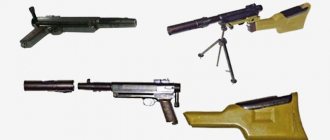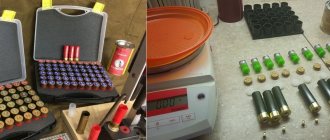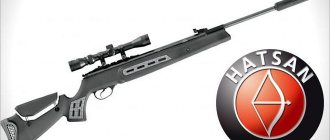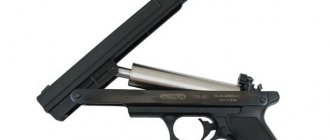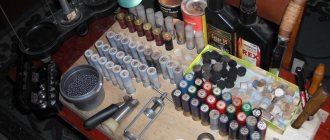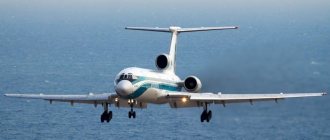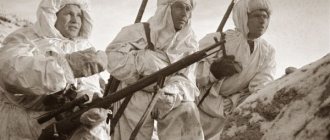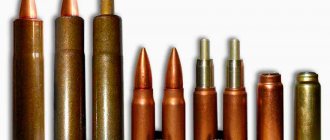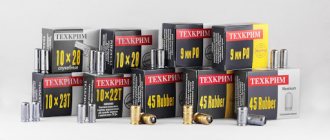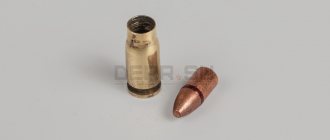Question about sniper cartridges.
To bookmarks
My friends, good morning to you))) In addition to everything, I want to give one more piece of advice to snipers! The palette of cartridges used is quite wide and varied. But are all cartridges good? I noticed that many of our snipers for the most part use simple cartridges with an ordinary bullet with a steel core of 7.62 LPS (LPS - light bullet with a steel core). The cartridge is good, but it is universal and is mainly intended to defeat enemy personnel located openly and behind light barriers, as well as non-armored ones.
Main characteristics of the 7.62 LPS cartridge Cartridge weight, g………………………………………………………..21.8 Bullet weight, g……………………………… ……………………….9.6 Initial bullet speed, m/s…………………………….820 But we have another problem! Terrorists actively operating in the South Georgia are not only excellently armed, but also equipped. It’s easy to notice the 3rd and 4th generation body armor and helmets on them! With simple cartridges, using sniper rifles from a long distance is extremely ineffective. This forces the sniper to approach enemy positions directly, which significantly increases the risk of being captured or under heavy, dense, targeted machine gun and machine gun fire. It is unacceptable! The sniper must work from a sufficiently large distance and with his aimed fire to kill in the appropriate way to ensure the advance, defense or withdrawal of our troops. I won’t expand, but a sniper has a lot of useful work! So, brothers, immediately demand that your commanders provide you with 7.62 mm 7N14 (or 7H1) sniper rifle cartridges with an SNB sniper armor-piercing bullet (GRAU index 7H!14). Which is specifically designed to defeat enemy personnel, I especially emphasize - equipped with personal protective equipment such as body armor, helmets, shields, etc., as well as lightly armored ground vehicles! Now, read the next paragraph well and think about what has been said! Penetrating effect of bullets from a 7.62×54 mm cartridge: A steel helmet is pierced by a bullet at a distance of 1700 m. A bulletproof vest of protection class IV (according to Russian GOST R 50744-95) is pierced at a distance of 1200 m. A steel sheet 10 mm thick is pierced at a distance of 400 m. Armor 7 mm thick at a meeting angle of 90° is pierced at a distance of 550 m. Brickwork is pierced at a distance of 200 m to a depth of 18-20 cm. A parapet made of densely compacted snow is pierced at a distance of 1000 m to a depth of 80-100 cm. An earthen barrier made of loose poured sandy loam soil breaks through at a distance of 1000 m to a depth of 30-45 cm. Dry pine beams measuring 20x20 cm, fastened in stacks, breaks through at a distance of 1200 m to a depth of 28 cm. Well, are you impressed? Same thing! )))) Most importantly, you can safely work at distances of up to 1200 - 1500 meters, while being invulnerable and practically safe! By the way, 7N14 cartridges have no visual difference from 7N1 and LPS cartridges. The only difference is the labeling. On the packaging: a black stripe and the inscription “SNIPER”. Another cartoon, these 7N14 sniper rifle cartridges with the SNB sniper armor-piercing bullet currently have no analogues in the world! In addition, weapons on which this cartridge can be used: Mosin rifle, VS-121, GShG, DS-39, DP/DPM, DT, MS-74, MTs-116, MT, PKP, PK/PKM, RP-46, SVT, SVD, SVK, SVU, ShKAS, S-49, as well as on many foreign systems. Well, brothers, as they say, don’t light a cigarette three times? Good luck to you and return home soon with victory! Glory to Ukraine! full!
7.62 mm rifle and machine gun cartridges of the 21st century
US cartridge with reduced bullet speed
7.62 mm US rifle cartridge with reduced bullet speed
Along with the Soviet Armed Forces, the standard 7.62 mm Mosin repeating rifle mod. 1891/30 It was also widely used by state security agencies. In the mid-1930s, the designers of a special laboratory, brothers V.?G. and I.?G.?Mitins developed, on instructions from the NKVD, several types of silencers with expansion-type chambers to equip the Mosin rifle. In 1938, a new set of special small arms, equipped with devices for silent and flameless shooting, known under the general index named after the inventors - “BRAMIT”, which were produced by the Tula Arms Plant until the end of the war, was adopted by the Red Army and the NKVD. These devices were used for shooting from standard weapons - rifles mod. 1891/1930 and a DP light machine gun.
Two rubber seals 15 mm thick in two chambers of the BRAMIT device were designed for several dozen shots. During the Great Patriotic War, rifles with BRAMIT devices were equipped with the most trained riflemen in reconnaissance and sabotage groups of the Red Army, the NKVD and partisan detachments operating in territory temporarily occupied by the enemy. For firing from Mosin rifles with the BRAMIT device, special 7.62-mm US rifle cartridges with a reduced charge of gunpowder and a light L bullet were used. The charge in this cartridge was VT grade gunpowder weighing 0.45 grams, which was selected in this way so that the initial speed of the bullet is subsonic and is no more than 260 m/s. This, in combination with a device for silent-flameless shooting, ensured muffling of the sound of the shot. To distinguish the US cartridge, the entire bullet and the bottom of the cartridge case were painted with green varnish, and for the cartridge intended for firing from a DP machine gun, in addition, the entire cartridge case was completely painted with black varnish.
Double-bullet cartridge with increased fire density DPP
7.62-mm double-bullet machine gun cartridge with increased fire density DPP (index 9-A-4011)
At the end of the 1960s, the redirection of helicopters, previously used in the Air Force mainly as a transport vehicle, for use as a multi-purpose combat weapon served as the starting point to create fundamentally new systems of small aircraft weapons. In the early 1970s, the Tula Design Bureau (KBP) began full-scale work on the design of multi-barreled machine guns with a rotating block of barrels, with a gas-type automatic drive, which significantly increased the rate of fire of the weapon. Soon, as a result of this work, two four-barreled machine guns appeared - 7.62 mm GShG-7.62 caliber - designed by V.?P.?Gryazev, A.?G.?Shipunov and E.?B.?Glagolev and 12.7 caliber mm - designs by P.?G.?Yakushev and B.?A.?Borzov.
For firing from the GShG machine gun with a rate of fire of 6000 rounds per minute, a special two-bullet cartridge with increased fire density DPP was developed. Soviet gunsmith designers managed to fit two bullets into the standard weight and overall dimensions of a 7.62-mm rifle-machine-gun cartridge, which significantly increased the likelihood of hitting a target from an aircraft weapon at high flight speeds. The bullets in the new DPP cartridge had a bimetallic shell with a lead core pressed into the first bullet and a steel core into the second bullet. The length of the first bullet was 28 mm (weight - 8.8 g), the length of the second bullet was 20.3 mm (weight 6.4 g). The difference between the initial speeds of the bullets was approximately 35 m/s. The new cartridge, designated 9-A-4011, increased the efficiency of the 7.62-mm four-barreled machine gun GShG-7.62 (TKB-621), adopted for service with Mi-24A combat helicopters in 1979, by one and a half times.
Sniper cartridge CH
Changes in the methods of modern combat, the nature of targets and the level of their protection led at the end of the twentieth century to a change in views on the role, place and tasks solved with the help of small arms, which led, in turn, to the improvement of designs consisting of supplying cartridges, and the creation of their new types and species.
With the adoption of the 7.62-mm Dragunov sniper rifle into service by the Soviet Army in 1963, work on the creation of a sniper cartridge continued. To increase the efficiency of fire from the Dragunov SVD rifle, a group of designers from NII-61 (formerly NII-44) under the leadership of P.?F. Sazonov. and Dvoryaninov V.?N. together with a group of designers from the design bureau of cartridge plant No. 188 (currently the Novosibirsk Low-Voltage Equipment Plant) under the leadership of R.?I. Khazansky began carrying out research and development work to improve the accuracy of fire from a sniper rifle by improving the characteristics of the cartridge.
The best results were shown by the bullet developed by P.?F.?Sazonov and V.?N.?Dvoryaninov - when shooting at a distance of 300 m, the accuracy was no more than 11 cm. In 1963, this bullet was recommended for further development. But already in 1964, the GRAU established new requirements for the sniper cartridge:
- the cartridge had to have a standard bimetallic sleeve;
- the cost of the cartridge should not be significantly higher than the cost of the gross cartridge;
- the accuracy of fire should not be inferior to the accuracy of a bullet from the CP sports cartridge.
The design team, despite the obvious complexity of the task, managed to fulfill all the requirements of the GAU, and in 1967 the 7.62-mm rifle sniper cartridge with the SN bullet was adopted by the Soviet army under the designation “7 N1”. For the first time in the world, Soviet ammunition designers managed to create a technologically advanced design for a high-accuracy sniper bullet with a steel core. It differed from an ordinary rifle cartridge in the design of the bullet and the increased precision in the manufacture of elements. It was intended for firing from the Dragunov SVD sniper rifle to engage manpower at ranges of up to 1300 m. The most effective shooting was at a distance of up to 800 m.
The PS (formerly SNPS) bullet of the sniper cartridge consisted of the following elements: a bimetallic shell, a steel core made of St. steel. 10 (substitute materials - Art. 15; Art. 20; Art. 25), made by stamping without further mechanical and thermal treatment and a lead core made of lead grade C4. In the head of the CH bullet in front of the core there is a small void, the presence of which is due to the complexity of stamping the pointed core. The mass of the SnPS bullet was 9.8 g, which practically corresponded to the mass of the LPS bullet (9.6 g) and ensured that the trajectories of sniper and conventional bullets were matched.
Despite the simplicity of the design of the sniper bullet and its general similarity with the design of the general-purpose bullet, a number of design and technological differences of the CH bullet make it possible to distinguish it into a separate class of special single-action bullets.
7.62-mm sniper rifle cartridge with a CH bullet with a steel core (index 7N1)
The sniper cartridge bullet has a composite core - a stamped steel head and a lead main one. Unlike the LPS bullet, the steel core is located directly in the head (ogival) part of the shell and does not have a lead jacket around it, and the lead core occupied the leading and conical bottom part of the bullet. This made it possible to optimize the location of the bullet’s center of gravity and avoid technological eccentricity of the steel core, since the latter began to be precisely fixed inside the shell. It was the eccentricity of the steel core that was the main reason for the increased dispersion of LPS bullets. The ogive-shaped steel core has a truncated apex, which forms a cavity about 3 mm deep in the head of the bullet. The formation of the cavity is explained by the difficulty of stamping pointed cores. The rear cone angle has been increased to 10 degrees. The introduction of a steel core into the design of a sniper bullet not only ensured lead savings, but also made it possible to reduce the mass of the bullet to the value of the mass of the LPS bullet, which served to fulfill the requirement of matching their trajectories. Without the steel core, the total mass of the bullet would be about 12 grams. The edges of the bullet tail shell are cut without seaming and form a lower open cavity 2.5 mm deep. The location of the steel core in the head reduced the eccentricity of the bullet, providing greater accuracy while maintaining penetration. The head-core bullet design turned out to be so successful that it was used for bullets of the 5.56x45 NATO cartridges; 9×39 SP. 5;12.7x108 CH, etc.
Despite the complete external similarity of the 7 N1 mod. 1967 with a gross 7.62-mm rifle-machine-gun cartridge with an LPS bullet, the difference between them is very significant. The dimensions of the cartridge case and the CH bullet and its elements, their outlines, and mass characteristics are maintained with high accuracy. Tolerances in the manufacture of sniper bullets have been halved compared to bullets from standard rifle cartridges. This is very important, since even a slight change in the weight of the bullet in one direction or another has a significant impact on the results of shooting at long ranges.
Sniper cartridge SNB
In terms of penetration properties, the sniper bullet of the 7 N1 cartridge is somewhat inferior to the LPS bullet. Until a certain time, this did not matter much. However, already in the mid-1980s, due to the spread and rapid improvement of personal armor protection, the penetrating properties of the CH bullet came to the fore. To compensate for this lack of sniper cartridge bullets, in the mid-1980s, TsNIITOCHMASH, in collaboration with the design bureau of the Novosibirsk Low-Voltage Equipment Plant, developed a new armor-piercing rifle sniper bullet based on the SN bullet.
In 1986, several variants of sniper armor-piercing bullets with pointed cores made of U12 A tool steel with additional heat treatment (instead of the St. 10 steel core in the 7 N1 cartridge) were presented for testing. In terms of penetration properties, experienced sniper bullets were significantly superior to the standard SN bullet, but they had unstable hardness of the armor-piercing core. The design team, consisting of V.?M.?Bobrov, V.?N.?Dvoryaninov, and V.?A.?Nikolaev, continued to refine the bullet until the end of the 1990s. In mid-1999, new tests of a modified sniper armor-piercing bullet (SNB) took place. During the tests, the high characteristics of the bullet were confirmed. The new cartridge was not inferior to the 7 N1 cartridge in terms of accuracy of fire and met the requirements for trajectory matching. The penetration properties of the SNB sniper bullet when fired from an SVD rifle were:
- on body armor 6 B5-15 - at a distance of 100 m - 100% through holes, at 200 m - 0% through holes;
- on body armor 6 B5-13 - at a distance of 550 m - 80% through holes, at 630 m - 55% through holes.
A steel sheet 10 mm thick was pierced by an SNB bullet from a distance of 300 m. In terms of penetration of a steel sheet, an experienced SNB bullet was 3.5 times superior to a standard SNB bullet. while the same CH bullet at a distance of 250 m did not penetrate an armor plate at all) or a sheet of grade 3 steel 10 mm thick. The range of destruction of targets wearing class III body armor has increased 11 times.
7.62-mm sniper rifle cartridge with SNB sniper armor-piercing bullet (index 7N14)
Bullets of sniper rifle cartridges 7 N1 and 7 N14, as well as bullets of sporting rifle cartridges, are not distinctively painted to avoid the influence of varnish on the accuracy of fire. Therefore, to distinguish the sniper rifle cartridge with the SNB bullet from other cartridges, it received a distinctive coloring with varnish - a violet-colored sealant at the junction of the cartridge case with the bullet. In addition, the closure of these cartridges bears repeating “Sniper” inscriptions and a black stripe.
At the end of 1999, a 7.62-mm sniper rifle cartridge with an SNB sniper armor-piercing bullet, designed to destroy manpower, including those equipped with personal armor and lightly armored ground vehicles, was adopted by the Russian army under the designation “7 N14”. The adoption of a sniper cartridge with an SNB bullet turned out to be very relevant, which was soon confirmed during the fighting in the Chechen Republic, since the wearing of body armor in the combat zone became almost universal, significantly reducing the range of effective sniper fire. Sniper cartridges 7 N1 and 7 N14 are produced only at the Novosibirsk Low-Voltage Equipment Plant.
7 N1 sniper rifle cartridges with a CH bullet were the first and for a long time the only special military cartridges for sniper weapons in the world. 7 N14 sniper rifle cartridges with the SNB sniper armor-piercing bullet currently have no analogues in the world. Standard army sniper rifle cartridges 7 N1 and 7 N14 have a lower bullet mass, corresponding to the mass of an ordinary bullet (9.6 g), which allows for the matching of the bullet trajectories of conventional and sniper cartridges and the use of a single sight scale. It should be noted that the adoption of a sniper cartridge with a bullet weight of 9.8 g did not cause changes in the NSD shooting tables for the SVD sniper rifle, where all ballistics information is given for the LPS bullet weighing 9.6 g. The calibration of the optical sight PSO- 1 is also made for the LPS bullet. However, when firing from sight 3 at a distance of 300 m, the average decrease in the trajectory of a heavier sniper bullet compared to the LPS is 11 cm (the decrease in the trajectory of a bullet weighing 11.75 g of the “Extra” target cartridge is 31 cm). Therefore, in order to hit the target, the sniper must draw up a shooting table himself, determining what range the standard settings of the PSO-1 sight of the SVD sniper rifle correspond to for the sniper cartridge.
Increased penetration bullets
ST-M2 bullet
Massive equipping of manpower with personal protective equipment (body armor of various classes), saturation of troops with lightly armored equipment, changes in the forms and methods of combat have significantly increased the requirements for the effectiveness of small arms cartridges, primarily in terms of increasing their penetrative effect, accuracy and firing range, which required taking adequate measures, first of all, from ammunition designers. Therefore, the main efforts of Soviet gunsmiths were focused on enhancing the penetrating effect of bullets from the 7.62 mm rifle-machine-gun cartridge.
First of all, the LPS bullet underwent modernization - as the most common and intended to perform the majority of fire missions. The required result was achieved by using a core made of special or heat-strengthened steel in the design of the new bullet.
7.62-mm rifle-machine-gun cartridge with a bullet of enhanced penetrating action ST-M2
The development of bullets of enhanced penetrating action for a rifle cartridge began in the mid-1980s at TsNIITOCHMASH and Research Institute No. 3 GRAU of the USSR Ministry of Defense, with the participation of design bureaus of cartridge factories. Employees of TsNIITOCHMASH P.?F.?Sazonov, V.?N.?Dvoryaninov and V.?M.?Bobrov together with the designers of the Novosibirsk Low-Voltage Equipment Plant N.Ya. Ulyanin and V.?N.?Larin, with the participation of Konstruktorsky process engineers The automatic line bureau began work on a radical modernization of the LPS bullet.
Based on the results of tests, the ST-M2 bullet with a heat-strengthened core was adopted into service by the Soviet Army as the one that best met the requirements of the tactical and technical specifications. It was intended to defeat enemy personnel located openly and behind barriers pierced by bullets, as well as lightly armored vehicles. The ST-M2 bullet had a penetrating effect significantly superior to that of the LPS bullet, and could effectively hit targets protected by body armor with armor elements based on boron carbide. Thus, at a distance of 180 m when firing from an SVD sniper rifle, the ST-M2 bullet provided 100% penetration of 6 B5-15 body armor, which is almost 2 times higher than the same figure for the LPS bullet. Body armor 6 B4 penetrated from a distance of 540 m. In terms of its performance, the new bullet was actually armor-piercing. When firing a cartridge with an ST-2 M bullet at a range of 100 m, the accuracy was no more than 3 cm, and at a range of 300 m - no more than 9 cm. During its production, the technology for manufacturing a steel core from other grades of steel was developed (Art. 70, Art. 75) - substitutes for 65 G steel. The ST-M2 bullet (or simply ST) replaced the LPS bullet, the production of which was discontinued in 1988. But since the ST-M2 bullet was intended to perform the same tasks as the LPS, the designation and marking of the cartridges with the ST-M2 bullet was left the same - LPS. A new cartridge with a bimetallic sleeve has been produced by the Novosibirsk Low-Voltage Equipment Plant since 1989. Cartridges with the ST-M2 bullet, like LPS, do not have a special distinctive coloring of the bullets, so they can only be distinguished by the year of manufacture and the stamp (number) of the manufacturer.
High penetration bullet PP
In 1989, on the basis of the ST-M2 bullet, the design bureau of the Barnaul Machine Tool Plant, leading designer D.I.Veronsky, developed a new PP (increased penetration) bullet for the 7.62 mm rifle-machine-gun cartridge. In terms of its design and the type of materials used in its manufacture, the PP bullet was actually a lightweight armor-piercing bullet.
The design of the PP bullet has a number of original features. For example, the lead jacket does not cover the entire core, so there is free space in the head part of the shell above the ogive part of the core. The lower edge of the shell, like that of the ST-M2 bullet, is not rolled inward. This bullet design made it possible to optimize the process of penetration of the armor-piercing core into a solid barrier. The pointed core of the PP bullet (similar in shape and size to the core of the B-32 bullet) is made by stamping from tool steel grade U12 A, followed by heat treatment (hardening). The length of the PP bullet core is 28.8 mm, the core weight is 5.24–5.44 g. Other elements of the bullet are made of the same materials as the LPS bullet. The ability to manufacture a core from tool steel by stamping on rotary conveyor lines followed by sharpening the bullet tip on machines with numerical control and hardening made it possible to keep the cost of the bullet within reasonable limits, while its armor-piercing properties increased significantly.
7.62-mm rifle-machine-gun cartridge with a bullet of increased penetration PP (index 7N13)
This cartridge fully meets the requirements for trajectory compatibility, and the penetrating effect of the PP bullet significantly exceeds that of bullets of gross rifle cartridges of any type. For example, when firing from a PKT machine gun at a distance of 200 m, the PP bullet provides 70% of the through holes of a standard armor plate made of 2 P steel grade 10 mm thick at an angle of 900, which practically corresponds to the same indicator as the B-32 armor-piercing bullet, and the body armor 6 Zh85 T bullet The PP penetrated at a distance of 800 m. Since the cartridge with the PP bullet fully meets the requirements for trajectory compatibility, and its external ballistic characteristics correspond to the LPS bullet, cartridges with these bullets can be used for firing from all types of weapons chambered for the 7.62 mm rifle-machine-gun cartridge without sight adjustment.
In 1993, a 7.62-mm rifle-machine-gun cartridge with a PP bullet was adopted for service under the designation “7 N13”. It was intended to destroy enemy personnel, including those equipped with personal armor protection and lightly armored ground vehicles.
The production of bullets with increased penetration for the 7 N13 cartridge was launched at the Barnaul Machine Tool Plant in 1997. The cartridge with a bullet of increased penetration was tested both with a bimetallic sleeve - 7 N13 (produced by the Novosibirsk Low-Voltage Equipment Plant, and since 2000, by the Barnaul Machine Tool Plant) and with a varnished steel sleeve - 7 N13-01 (produced by the Barnaul Machine Tool Plant).
The PP bullet of the 7 N13 cartridge does not have a special distinctive color, but they can be distinguished from rifle-machine-gun cartridges with other types of bullets by the color of the sealant varnish at the junction of the bullet and the cartridge case. It has been changed from red to purple. The use of a sealing varnish coating on the 7 N13 cartridge as a distinctive bullet color was first used in domestic practice.
Armor-piercing bullet BP
In the mid-1990s, in the design bureau of the Novosibirsk Low-Voltage Equipment Plant, a team of designers led by Ulyanin N.Ya. and Nekrasova I.?O. a new armor-piercing bullet was developed, which received the index “7 BM4” for the 7.62-mm rifle-machine-gun cartridge. The cartridge with this bullet entered testing in September 1999. Structurally, the armor-piercing bullet is designed similar to the bullet with increased penetration of the 7 N13 cartridge and differs from the latter mainly in the processing of the armor-piercing core, which in the 7 BM4 bullet is made by stamping from tool steel grade 70 with additional forging. Unlike a bullet with increased penetration, the armor-piercing bullet 7 BM4 has a core entirely surrounded by a lead jacket. The length of the core is 30.5 mm, the diameter is 6.14 mm, the weight of the core is 5.55 g. The bullet shell is made of 11 kp steel, clad with tombac on both sides, the lower edges of the shell are left free.
The 7.62-mm rifle-machine-gun cartridge with an armor-piercing BP bullet was adopted by the Russian army under the designation “7 N26” in 1999 and was intended to defeat enemy personnel equipped with personal armor protection and ground armored vehicles. In its penetrating properties it is somewhat superior to the PP bullet (when fired from a PKT machine gun at a range of 200 m, it provides 90% of through holes in a 2 P armor plate with a thickness of 10 mm at an angle of 900 to the horizontal, which is 15% greater than the penetrating effect of the PP bullet, and firing range of 200 m provides 80% of through holes). The cartridge with the BP bullet was tested in a bimetallic sleeve and its production has been established at the Novosibirsk Low-Voltage Equipment Plant since 2000.
7.62-mm rifle-machine-gun cartridge with an armor-piercing bullet BP (index 7N26)
The result of colossal research and development work carried out by domestic gunsmiths is that the 7.62-mm cartridge remains one of the most widespread cartridges of this class in the world . The modernization of bullets for it, carried out at the end of the 20th - beginning of the 21st century, allowed this cartridge to stand on a par with the best Western analogues, thus proving that the capabilities of the Russian rifle and machine gun cartridge of the 1891 model are far from being exhausted.
The development of highly effective cartridges, carried out in recent years, has significantly improved the basic characteristics of domestic small arms. In total, the Russian Army currently has more than 120 ranges of small arms cartridges in service.
The use of small arms cartridges with increased penetration for ultra-precise shooting over long distances (1.5–2 km) significantly facilitates the solution of problems associated with the liquidation of terrorist organizations. So, for example, in 2006, the Design Bureau of Automatic Lines named after L.N.Koshkin, with the participation of the Ulyanovsk and Tula Cartridge Plants, developed new cartridges with increased penetration and improved accuracy. And today work in this direction continues actively.
As an example, we can cite the activities of only one of many defense enterprises - OJSC "Design Bureau of Automatic Lines named after L.?N.? Koshkin", where, to ensure the updating of the range of cartridges, the improvement of technological processes for the manufacture of cartridges and special technological equipment for their production has been established and in As part of the development work “Fable”, “Packaging”, “Coating P”, “Cartridge N”, technological processes for the production of new generation cartridges and special technological equipment for their production and disposal are being improved. This design bureau, together with cartridge factories, is capable in the near future of 3-4 years of modernizing existing production at factories throughout the industry for the production of small arms ammunition. At the same time, the designers of this KBA developed a project for creating “Module” type production facilities with an actual productivity of one chain of up to 800–1200 rounds per minute, which can ensure the production of small arms cartridges during the most intense period of a large-scale military conflict.
Sergey Monetchikov Photo from the author’s archive
Special cartridges for a special shooter
The sniper is met with a rifle. The sight, stock material, locking system, bipod - all this can tell a knowledgeable person a lot about the owner of the weapon. But for a real sniper, it is not enough to choose a suitable rifle: this is only half the task - to reveal its potential to 100%, you also need the appropriate ammunition. Today's short story is about the most common sniper calibers.
"Old Russian"
When at the end of the 19th century Russian Colonel N.F. Rogovtsev was designing a new cartridge for the future “three-line”; they didn’t even think about the need to develop special sniper ammunition. Even in the USSR in the early 30s, when millions of people went through OSOAVIAKHIM shooting courses, receiving the badges of the “Voroshilov shooters”, and a lot of work was being done to create optical sights for snipers, it was still proposed to use a regular gross cartridge for them.
The special sniper cartridge 7N1 7.62×54 is not specially marked and looks like an ordinary rifle.
Interest in creating a special sniper cartridge appeared after the Great Patriotic War. Thus, in one of the reports from the shooting range of the Main Artillery Directorate of the Red Army from 1949 on the testing of experienced sniper rifles, there is a mention that the shooting was carried out with Finnish Lev cartridges, since domestic cartridges did not allow the full potential of the modernized rifles to be revealed in comparison with the serial ones. Unfortunately, the report does not indicate which cartridges we are talking about: the emblem with a golden lion in a red circle adorned several different cartridges produced in the small Finnish town of Lapua. In addition to orders for the army, the plant also developed and produced ammunition for athletes, creating a number of very successful cartridges in the “Russian” caliber 7.62x54R.
By this time, the “cartridge” NII-44 had just received an order to begin developing special sniper cartridges, and with reference to the Finnish experience. The result of long work was the appearance of the 7N1 sniper cartridge, and then its version with improved armor penetration 7N14, which became the main type of ammunition for the SVD - the Dragunov sniper rifle.
In the game "Caliber" the sniper of the special forces "Recruits" is armed with an SVD rifle,
which is where the acquaintance with the game begins
It is believed that the longest sniper shot from an SVD was made in 1985 in Afghanistan, when a sniper of the 345th Airborne Regiment, Sergeant Vladimir Ilyin, shot a Mujahideen from a distance of 1350 meters. Unfortunately, there is no official information about the circumstances of this shooting.
American family
The American cartridge 7.62x51 NATO, also known as .308Win, appeared much later than its Russian counterpart 7.62x54R - already in the middle of the 20th century. It occupies approximately the same niche both in purpose and in characteristics, and is the main rifle and machine-gun ammunition in many countries around the world.
As for sniper cartridges, it was much easier for the American military than for their Soviet counterparts. If in the USSR the production of ammunition was strictly controlled by the state, then in the USA, with a huge number of people interested in shooting, including high-precision shooting, the army often only needed to formulate a problem and choose the most suitable proposal.
Nevertheless, at first the path of American sniper ammunition turned out to be very similar to the Soviet one. In the 1950s, having adopted a new cartridge for service, the US Army Weapons Department ordered specialists from the Frankford Arsenal to develop a version for snipers based on a sports cartridge - although not Finnish, but their own. This is how the M118 cartridge appeared, early versions of which were successfully used by American snipers in Vietnam. But in the 70s, several changes were made to production technology, which reduced the cost of ammunition, but worsened its quality.
According to the recollections of veterans, the spread of different batches of cartridges could differ by three times, but even for the best it was significantly worse than commercial sports cartridges. As a result, the Marine Corps in 1993 formulated new requirements for the M118 Special Ball Long Range (LR) sniper cartridge. Since 1998, these cartridges began to be supplied to the troops.
The longest recorded shot from a sniper rifle chambered in .308Win was made in September 2005 in Ramadi, Iraq. American Staff Sergeant Jim Gilliland, who used an M21 self-loading sniper rifle, hit an enemy sniper from a distance of 1250 meters.
In the game "Caliber", a sniper
of the Polish special forces GROM uses the American M110 self-loading sniper rifle chambered for .308 Win
. However, combat operations in Iraq and Afghanistan showed that the new versions of the M118 were not without drawbacks: the sensitivity of the gunpowder used to temperature changes was especially significant. For the past few years, the U.S. military has been testing a new .308Win sniper round called the Mk316 Mod 0. It uses a 175-grain (11.34 gram) Sierra Match King bullet and uses a new powder with greater temperature stability. According to some reports, new ammunition is being tested by American special operations forces.
Many special forces around the world also use the latest commercial sporting (target) ammunition for their rifles chambered in .308Win. There are many cartridges on the civilian market that are optimized for long-range shooting and can significantly expand the capabilities of such weapons. This also allows you to increase the range of tasks that can be solved, not limited only to long-range and accurate shots. For example, according to the FBI, the Trophy Bonded Bear Claw bullet does a good job of breaking armored glass, which is a problem with some other types of bullets. In situations where there is a danger of hitting someone behind the target, polymer-tipped bullets are used.
In the game "Caliber" the
Arctic Warfare Magnum-Folding (AWM-F) is owned by the sniper of the
"
FSB 2016
"
Russia is also currently developing a sniper cartridge in this caliber, but for now special forces armed with foreign rifles also use imported cartridges.
Quiet Soviet cartridge
Another direction was the development of special cartridges for silent sniper systems. For many years, subsonic versions of conventional caliber cartridges were used for shooting with silencers, but in the 1980s, the USSR formulated requirements for new silent weapons for special forces units. One of the requirements was to penetrate a steel helmet at a distance of 400 meters.
Special cartridge 9×39 mm SP-5 with varnished steel sleeve
Tests have shown that a subsonic 7.62 mm cartridge will not be able to solve this problem. As a result, specialists developed a new 9x39 mm cartridge, as well as weapons for it - VSS (special sniper rifle), AS (special assault rifle) “Val” and a number of other samples.
In "Caliber" a special forces sniper is armed with a VSS rifle
«
FSB 2004
»
